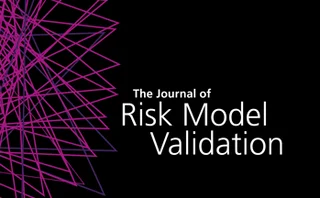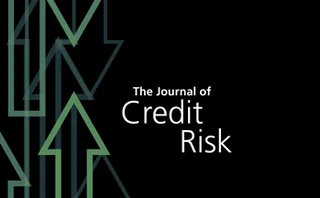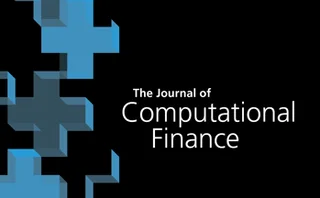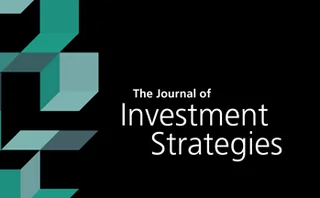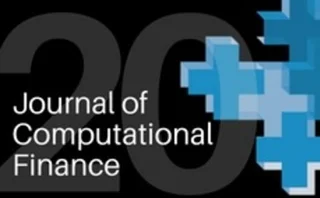Original research
A correlated structural credit risk model with random coefficients and its Bayesian estimation using stock and credit market information
Using historical equity and credit market data, this paper illustrates the validation of a structural correlated default model applied to Black–Cox setups.
Modeling joint defaults in correlation-sensitive instruments
This paper presents a simple model for joint defaults and shows how it can be applied to pricing and risk-managing instruments that are sensitive to credit correlation.
The effect of market conditions on forward-looking portfolio performance
The authors of this paper apply a forward-looking approach to the minimum variance portfolio optimization problem for a selection of 100 stocks.
The determinants of regime switching in the natural gas and crude oil cointegrating relationship
This paper aims to find determinants of the endogenous regime-switching process underlying the cointegrating relationship between natural gas and crude oil.
Value-at-risk bounds for multivariate heavy tailed distribution: an application to the Glosten–Jagannathan–Runkle generalized autoregressive conditional heteroscedasticity model
This paper aims to derive VaR bounds for the portfolios of possibly dependent financial assets for heavy tailed Glosten–Jagannathan–Runkle generalized autoregressive conditional heteroscedasticity processes using extreme value theory copulas.
Finite difference techniques for arbitrage-free SABR
This paper applies a variety of second-order finite difference schemes to the SABR arbitrage-free density problem and explores alternative formulations.
An analysis of energy futures
The authors of this study investigate the distributions of returns on crude oil, heating oil and natural gas futures.
Rapidly bounding the exceedance probabilities of high aggregate losses
The authors of this paper assess the right-hand tail of an insurer’s loss distribution for a specified period (a year), presenting and analyzing six different approaches in doing so.
A mixed Monte Carlo and partial differential equation variance reduction method for foreign exchange options under the Heston–Cox–Ingersoll–Ross model
The paper concerns a hybrid pricing method build upon a combination of Monte Carlo and PDE approach for FX options under the four-factor Heston-CIR model.
Estimating credit risk parameters using ensemble learning methods: an empirical study on loss given default
This study investigates two well-established ensemble learning methods: Stochastic Gradient Boosting and Random Forest, and proposed two new ensembles.
Rating-transition-probability models and Comprehensive Capital Analysis and Review stress testing: methodologies and implementation
This paper introduces a risk component called the credit index, that represents the systematic risk part of a portfolio by a list of macroeconomic variables.
The forward smile in local–stochastic volatility models
The Authors introduce a closed-form approximation for the forward implied volatilities.
The convenience yield implied in the European natural gas markets: the impact of storage and weather
This paper aims to determine the convenience yield implied in the European natural gas markets by investigating driving factors and according dynamics.
Numerical solution of the Hamilton–Jacobi–Bellman formulation for continuous-time mean–variance asset allocation under stochastic volatility
The paper deals with robust and accurate numerical solution methods for the nonlinear Hamilton–Jacobi–Bellman partial differential equation (PDE), which describes the dynamic optimal portfolio selection problem.
High-performance American option pricing
This paper presents a high-performance spectral collocation method for the computation of American put and call option prices.
Adjusting exponential Lévy models toward the simultaneous calibration of market prices for crash cliquets
The authors propose so-called tail thinning strategies that may be employed to better connect the calibrated models to the crash cliquets prices.
Modeling redemption risks of mutual funds using extreme value theory
This paper shows how redemption risks of mutual funds can be modeled using the peaks-over-threshold approach from extreme value theory.
The impact of loan-to-value on the default rate of residential mortgage-backed securities
This paper analyzes the validity of using the loan-to-value (LTV) ratio to explain the behavior of mortgage borrowers at an empirical level.
An exact and efficient method for computing cross-Gammas of Bermudan swaptions and cancelable swaps under the Libor market model
A new simulation algorithm for computing the Hessians of Bermudan swaptions and cancelable swaps is presented.
The valuation of contingent convertible catastrophe debt under simple solvency and liquidity covenants
This paper studies a new write-off debt instrument (called CoCoCAT bond) whose writeoff is triggered by solvency and event-driven covenants.
Pricing swing options in electricity markets with two stochastic factors using a partial differential equation approach
This paper considers the numerical valuation of swing options in electricity markets based on a two-factor model.
Efficient computation of exposure profiles on real-world and risk-neutral scenarios for Bermudan swaptions
In the paper, real-world and risk-neutral scenarios are combined for the valuation of the exposure values of Bermudan swaptions on real-world Monte Carlo paths.
Relative performance persistence of financial forecasting models and its economic implications
This paper addresses the issue of model selection risk by examining whether a model’s past performance in forecasting expected returns provides an indication of its future forecasting performance.
